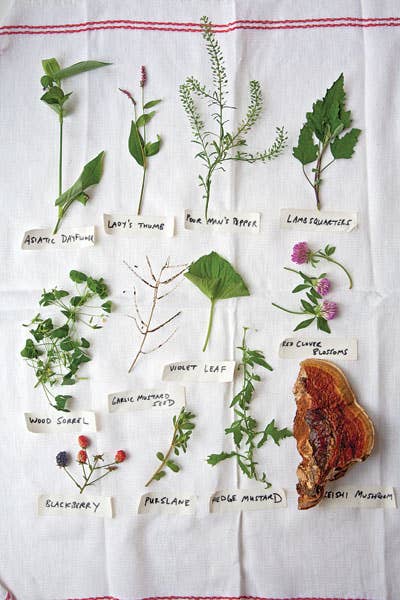
Eternal Spring: The Joy of Urban Foraging
What comforts us might be found right beneath our feet.
The first foraged food I ever ate was wild garlic. The allium grew at random in the courtyard of my mother's apartment building in Flushing, Queens, and as a kid, I used to pull the plant out of the ground and eat it raw; it reminded me of the scallions my Chinese grandmother used so liberally in her cooking.
Years later, when I was an adult and already living in Brooklyn, New York, I started foraging again after a breakup with a longtime boyfriend, using books like Euell Gibbons' Stalking the Wild Asparagus (Alan C. Hood and Company, 2005) as my guide. I got hooked when I discovered that wild mushrooms, berries, and weeds were growing all around me, in the parks near my apartment or even on the street, springing up through the cracks in the sidewalk. With my eye on the underbrush and my hands in the dirt, I eased myself out of the pain of lost love and got in touch with the senses of renewal and growth.
Ever since, I have marveled each spring as New York City—in a seasonal process that unfolds, improbably, in urban areas everywhere—transforms into a luscious salad. A sprig of wild epazote, that can turn mashed avocado into the best guacamole ever, dips in the wind, growing in a tree pit. A bitter-tasting dandelion, delicious baked in a tart with ricotta, thrives on the edge of a basketball court. Young shoots of Japanese knotweed invade yards; I transform them, with plenty of butter and sugar, into a rhubarb-like pie, or add them straight to a tangy salsa verde. While I am cautious about what I'll eat and carefully inspect where it's growing, it is life-affirming to know that even among the concrete and steel, nature provides a wealth of edible greens beneath our feet.
Last summer, I was rummaging in Brooklyn's Prospect Park for new finds (some of which are pictured, above) when my grandmother was rushed to the emergency room. A sprightly 92-year-old, she had recently transformed into an exhausted soul unable to walk. When she died a few days later, I did what I have learned by now to do when I am grieving; I went foraging. I took a slow, searching walk in the park, and when I reached a clearing I had visited numerous times before, I noticed a black thing the size of a dime drop from a tangle of bush to the ground. Looking closer, I saw dozens of blackberries under a canopy of arching stems and fingerlike leaves; their thorns caught on my shirt. I began picking. They were small, tart, and sweet—more petite and flavorful than the berries I buy at the supermarket. I stood there, navigating the bristly obstacle course of stems and leaves, gathering more of the delicious fruit. I didn't even mind my fingers' being pierced.
Keep Reading
Continue to Next Story










